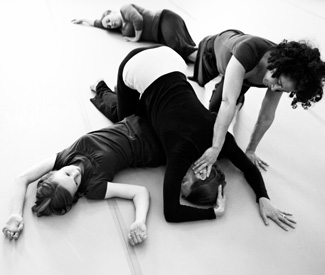arts@sfbg.com
DANCE Randee Paufve’s voice is quiet. But once you have heard her speak through her dances, you are unlikely to forget the strength of what she has to say. Her craft is impressive, her topics are many-layered, and the resulting choreography is pared down to its essence. Sometimes, I have even wished for a little more looseness just so I could catch my breath.
So I Married Abraham Lincoln takes on the life of Mary Todd Lincoln, wife and widow of a President, a life-long Washington outsider, the target of vicious gossip, a spiritualist, perhaps mentally unstable, and a mother of four sons — only one of whom outlived her. In this hour-long work, set on seven primary and nine additional dancers, Paufve examines the sense of restriction — personal, social, political — with which this Kentucky-born outcast, a free spirit at one time, had to cope.
>>View our slideshow of Paufve Dance’s So I Married Abraham Lincoln
Though Married starts with the figure of Todd Lincoln, it opens up to include all the First Ladies whose identities disappeared into their positions. In the work’s main section, in a take-off on beauty pageants, they parade down a runway cooing their first names. Taking a broader perspective, Paufve also addresses the toll taken when anyone — one of the wives is danced by a man — is forced into a role and is not allowed to be him or herself.
Married is structured in the now-fashionable installation format, in which the audience travels through a series of episodes. At its premiere at Dance Mission Theater, it opened with an informal lobby overture of short individualized solos that were probably meant to highlight each dancer’s uniqueness (sight lines were difficult). Then Paufve moved the show down a narrow hallway, segueing through several studios and ending in the theater proper. The idea, again, was clearly to focus on one woman and then widen the lens. Theoretically, the format looked good, but the logistics of having to squeeze all the audience members (the show was more than sold out) through narrow doorways, and then cram them into places to sit, stand, or lean, impeded the piece’s flow.
Todd Lincoln first appears on a throne-like chair at the end of the hallway, contemplating her life and people’s expectations and misperceptions of her. Her words echo back to her as from another world. A couple of scenes later, we find ourselves around a low table outlined with burning tea lights. Two women in white shifts (costumes by Keriann Egeland) anxiously crowd into a corner. Perhaps they are ghosts, perhaps they are mourners. The real action, however, happens above the table where — in a stroke of genius — designer Jack Carpenter suspended linked teacups over the candles. The rising heat makes the cups tinkle, and they gently dance.
Though it has its moments of levity and softness, Married aims for a stark, uncompromising perspective, with choreography that is linear, pattern-oriented, and rigorous. It’s powerful in the way it suggests a sense of objectification. You sense an invisibly controlling hand as women are moved around like figures on a chessboard. In the last scene, they parade, they strut, they primp, and they pose. When the bugle calls, off they march. You watch Todd Lincoln awkwardly trying to weave gaudy flowers into her hair, and you hear a voice cry out against “that ugly home,” presumably the White House. Several times in the middle of scurrying activity, like a photo you can’t forget, you see identical images of a body being mourned. Lincoln? His sons? Soldiers, then and now?
At the same time, Heather Heise’s lovely songs recall wistful folk traditions and suggest the possibility of a communal purpose. Beginning with a single voice, the music opens into rich harmonies. One of tunes starts with “Oh Mary, don’t you weep, don’t you mourn.” And as the piece comes to a quiet ending, the women sing “Oh where are our dear mothers?/They are gone to heaven a’shouting/Day is a’breaking/In my soul.”

